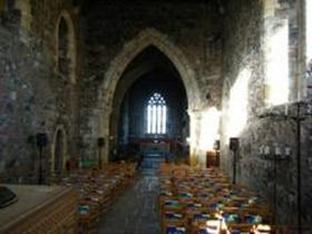
I was at the event to give one of the inputs. My topic was: Open to All? I had been asked to explore what it would mean to include others in these pilgrimage routes. I didn’t focus on people of no faith, some of whom would be happy simply to walk in the Scottish countryside with no thought or care for the religious significance of any of the places along the route. This might not be so for people of faiths other than Christian for whom pilgrimage is a religious and spiritual practice.
There’s not a religion that doesn’t have a sacred site which it honours and venerates as a place of spiritual energy. Muslims travel to Mecca on pilgrimage and are asked to do this at least once in their lives. Those I know who’ve gone have been touched by the sense of community and spiritual power. Remembering their origins has confirmed them in their faith and reconnected them (re-membered them) in the Ummah, the Muslim family. Likewise Sikhs connect at a profound level with their faith at the Golden Temple in Amritsar. I’ve a friend who recently visited the Golden Temple and was struck by the power of it all and the wonderful generous hospitality found in all Sikh places of worship. I’ve been lucky enough to have visited Sarnath, near the Hindu holy city of Varanasi. Sarnath is where the Buddha preached his first sermon and established his sangha after his enlightenment at Bodhgaya. There’s no doubt it’s a special place and the spiritual atmosphere is tangible, I’m sure strengthened and deepened by the obvious devotion of the Buddhists meditating and praying there.
While I’ve been moved by some of the sacred places I’ve visited I did wonder how possible it would be to open up and advertise the Christian Celtic pilgrimages as meaningful and inclusive of other faiths. People of faith are able to sense the spiritual atmosphere anywhere I think so it’s not an impossibility. I’ve been on Iona with my good friend Ani Lhamo and we managed to have an interfaith dimension to the pilgrimage round the island that happens there every week. There were a number of Buddhists on the week we led and they were moved by the experience and the spirit of the island. I’ve also been to Holy Isle with its Buddhist Centre for Dialogue and Healing. One of the times I was there was with the religious leaders of Scotland and we were taken on a short pilgrimage across the island peppered with rock paintings of Buddhist saints and Bodhisattvas. The Moderator of the Church of Scotland happened to get his photograph taken beside a painting of Green Tara which caused an uproar among some members of his Church when it was published in a national newspaper – not everyone takes easily to participating in the Holy Places of other faiths. This Holy Isle, off the Island of Arran, is recognised as Buddhist but it does have a Celtic connection and the Buddhists are very happy to recognise this. St Molaise, an Irish saint from the 6th century lived for ten years in a cave on Holy Isle before travelling on to Rome for ordination. The cave is still there and is part of the Buddhist pilgrimage as is the flat raised rock on which it’s said he passed judgements on cases brought to him by people from Arran and the spring said to have healing properties.
So it’s possible for different faiths to recognise the Holy Places of other faiths but it can’t be taken for granted they will adopt these new Christian pilgrimages – perhaps because they’re minority faiths. There could be a concern that this desire to claim Scotland’s religious history is a way of re Christianising Scotland and stressing it’s a Christian country, rather than a secular one which is open to people of all faiths and none. Whatever happens it’s important that the new interest in pilgrimage doesn’t make people feel outsiders in their own country. I think’ there might be ways of doing this.
It’s quite possible that some of the pilgrimage ways include sites of pre-Christian religion and these too could be recognised. It might also be possible that some of the routes are near places associated with other faiths and these too could be visited. Many of the routes are in rural and wild parts of the country so this is unlikely but we can walk aware of the sacredness of the earth which is central to all faiths; any literature with prayers and readings to stress the spiritual nature of the walk can include those from other faiths; the story told can begin with the origins of religion in Scotland but developed to remember how our country has changed and now includes many faiths ; but perhaps more than anything it’s important to remember we walk this earth connected to the whole of humanity, that we belong to what Christians call the Communion of Saints and included in this are our fellow believers from all faiths.
I look forward to seeing how it all develops.


 RSS Feed
RSS Feed
